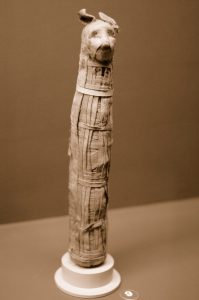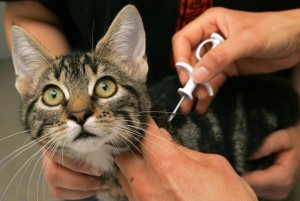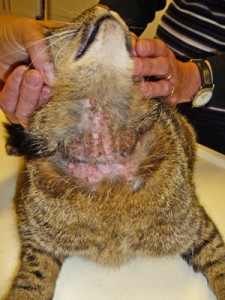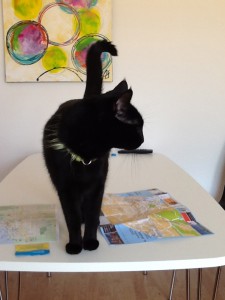 Erstmals haben Forscher sich im großen Umfang historische Katzen-DNA angeschaut – und nachgezeichnet, wie die Samtpfoten sich vom Nahen Osten und Ägypten aus als Haustiere über den gesamten Globus ausbreiteten.
Erstmals haben Forscher sich im großen Umfang historische Katzen-DNA angeschaut – und nachgezeichnet, wie die Samtpfoten sich vom Nahen Osten und Ägypten aus als Haustiere über den gesamten Globus ausbreiteten.
Tausende Jahre, bevor lustige Katzenvideos das Internet überschwemmten, strichen die Samtpfoten durch das alte Eurasien und Afrika – im Schlepptau von Farmern, Seefahrern und sogar von Wikingern. Das zeigt nun die erste umfassende Analyse historischer und prähistorischer Katzen-DNA. Für die Studie, die Forscher am 15. September 2016 auf einer Konferenz vorstellten, sequenzierten sie das Erbgut von mehr als 200 Katzen, die vor 15 000 Jahren bis hinein ins 18. Jahrhundert in verschiedenen Ländern auf der Welt gelebt hatten.
Wissenschaftler wissen bislang recht wenig über die Domestizierung der Katze und streiten noch darüber, ob die Hauskatze (Felis silvestris catus) wirklich ein domestiziertes Tier ist – ob sie sich hinsichtlich des Verhaltens und der Anatomie also deutlich von ihren wilden Verwandten unterscheidet. “Wir kennen die Geschichte der historischen und prähistorischen Katzen nicht, wissen nichts über ihre Herkunft oder wie sie sich ausgebreitet haben”, sagt Eva-Maria Geigl, Evolutionsgenetikerin am Institut Jacques Monod in Paris. Sie präsentierte die Untersuchung gemeinsam mit ihren Kollegen Claudio Ottoni und Thierry Grange auf dem siebten internationalen Symposium für biomolekulare Archäologie in Oxford
 In einer 9500 Jahre alten menschlichen Grabstätte auf Zypern entdeckten Forscher auch die Überreste einer Katze. Das weist darauf hin, dass die Verbindung zwischen Mensch und Katze mindestens seit dem Beginn der Landwirtschaft besteht, die im Fruchtbaren Halbmond vor rund 12 000 Jahren ihren Anfang nahm. Die alten Ägypter könnten wilde Katzen vor etwa 6000 Jahren gezähmt haben; unter den späteren Dynastien wurden Katzen millionenfach mumifiziert. Eine der wenigen Studien über historische und prähistorische Katzen-DNA beschäftigt sich mit mitochondrialer DNA (die im Gegensatz zur Kern-DNA nur mütterlicherseits vererbt wird) von drei mumifizierten ägyptischen Katzen.
In einer 9500 Jahre alten menschlichen Grabstätte auf Zypern entdeckten Forscher auch die Überreste einer Katze. Das weist darauf hin, dass die Verbindung zwischen Mensch und Katze mindestens seit dem Beginn der Landwirtschaft besteht, die im Fruchtbaren Halbmond vor rund 12 000 Jahren ihren Anfang nahm. Die alten Ägypter könnten wilde Katzen vor etwa 6000 Jahren gezähmt haben; unter den späteren Dynastien wurden Katzen millionenfach mumifiziert. Eine der wenigen Studien über historische und prähistorische Katzen-DNA beschäftigt sich mit mitochondrialer DNA (die im Gegensatz zur Kern-DNA nur mütterlicherseits vererbt wird) von drei mumifizierten ägyptischen Katzen.
Gefährten bis in den Tod
Geigls Team hat auf solchen Erkenntnissen aufgebaut, den Ansatz aber auf einen deutlich größeren Maßstab ausgedehnt. Die Wissenschaftler analysierten mitochondriale DNA der Überreste von gleich 209 Katzen, die Experten in mehr als 30 Ausgrabungsstätten in Europa, dem Nahen Osten und Afrika frei legten. Die Proben datieren von der Mittelsteinzeit – der Zeit unmittelbar vor dem Beginn der Landwirtschaft, als die Menschen noch als Jäger und Sammler lebten – bis hinein ins 18. Jahrhundert.
Die Katzenpopulationen scheinen in zwei Wellen gewachsen zu sein, entdeckten die Autoren. Wildkatzen aus dem Nahen Osten mit einer speziellen mitochondrialen Abstammungslinie breiteten sich mit den frühen bäuerlichen Gemeinschaften bis in den östlichen Mittelmeerraum aus. Geigl vermutet, dass die Getreidevorräte der ersten Farmer Nagetiere anlockten – und diese wiederum Wildkatzen. Nachdem die Menschen begriffen, welchen Vorteil die Gesellschaft der Samtpfoten haben kann, begannen sie möglicherweise damit, die Tiere zu zähmen.
Samtpfoten an Bord
Tausende Jahre später eroberten Katzen, die von Vorfahren aus Ägypten abstammten, schließlich rasch Eurasien und Afrika. Mitochondriale DNA-Merkmale, die bei ägyptischen Katzenmumien zwischen 400 v. und 400 n. Chr. verbreitet waren, traten zur gleichen Zeit auch bei Katzen in Bulgarien, der Türkei und Subsahara-Afrika auf. Seefahrer hielten vermutlich Katzen, um Nagetiere in Schach zu halten, sagt Geigl. Ihr Team fand Katzenüberreste mit dieser Abstammungslinie ebenfalls in Wikingerstätten im Norden Deutschlands, die auf eine Zeit zwischen dem 8. und 11. Jahrhundert n. Chr. datiert werden können.
“Die Studie enthält so viele spannende Beobachtungen”, sagt Pontus Skoglund, Populationsgenetiker an der Harvard Medical School in Boston, Massachusetts. “Ich wusste nicht einmal, dass es überhaupt Wikingerkatzen gab.” Er ist außerdem beeindruckt davon, dass Geigls Team wirkliche Bevölkerungsverschiebungen anhand von mitochondrialer DNA ausmachen konnte, die nur eine einzige mütterliche Ahnenlinie nachzeichnet. Dennoch denkt Skoglund, dass vor allem DNA aus dem Zellkern die noch bleibenden Fragen zum Thema Katzendomestikation und -ausbreitung klären könnte – etwa hinsichtlich ihrer Verwandtschaft mit Wildkatzen, mit denen sie sich nach wie vor kreuzen.
Geigls Team analysierte auch Kern-DNA-Sequenzen, die Katzen mit Tabbymuster ihr geflecktes Fell verleihen. Die Mutation, die dafür verantwortlich ist, tauchte nicht vor dem Mittelalter auf, entdeckten die Forscher. Geigl hofft, dass sie künftig noch mehr Kern-DNA von historischen und prähistorischen Katzen sequenzieren kann. Die Geldmittel für moderne Katzengenomik seien allerdings knapp. Das sei einer der Gründe dafür, dass sie der Hundeforschung noch weit hinterherhinke. Zum Vergleich: Auf derselben Konferenz verkündete ein Team, das sich mit der Domestikation von Hunden befasst, es bereite sich nun darauf vor, die Kern-DNA von mehr als 1000 verstorbenen Hunden und Wölfen zu untersuchen. Der scherzhaften Anmerkung, dass Hunde unter Forschern schlicht populärer zu sein scheinen als Katzen, widerspricht Geigl allerdings: “Wir können das auch schaffen. Wir brauchen nur das Geld dazu.”
Dieser Artikel ist im Original unter dem Titel “How cats conquered the world (and a few Viking ships)” bei “Nature” erschienen.
© Spektrum.de
Mumien-Foto © E. Michael Smith
 „Gerade zur Weihnachtszeit können wir nur immer wieder appellieren, keine Tiere – weder Hunde- noch Katzenwelpen oder andere Tierarten – aus dubiosen Quellen zu kaufen“, sagt Andreas Brucker vom Landesverband Bayern des Deutschen Tierschutzbundes, der die Katzenwelpen in Empfang genommen und ins Tierheim Feucht gebracht hatte. „Zwei der Boxen im Transporter waren leer, weshalb wir davon ausgehen, dass weitere 15 bis 20 Katzenwelpen bereits verkauft waren – vermutlich als Weihnachtsgeschenke.“ Der Ernährungszustand aller Tiere war grenzwertig, alle haben einen Wurmbauch. Ein erstes Kätzchen konnte schon bald nicht mehr selbstständig fressen und musste gefüttert werden. Die Tierschützer vermuten, dass die Tiere alle mit Medikamenten fit gespritzt wurden, da sie zu Beginn noch einen fidelen Eindruck machten und sich im Tierheim auf Wasser und Futter stürzten. Wer den Katzen und dem Tierheim helfen möchte, kann dies am besten mit einer Geld- oder Futterspende tun.
„Gerade zur Weihnachtszeit können wir nur immer wieder appellieren, keine Tiere – weder Hunde- noch Katzenwelpen oder andere Tierarten – aus dubiosen Quellen zu kaufen“, sagt Andreas Brucker vom Landesverband Bayern des Deutschen Tierschutzbundes, der die Katzenwelpen in Empfang genommen und ins Tierheim Feucht gebracht hatte. „Zwei der Boxen im Transporter waren leer, weshalb wir davon ausgehen, dass weitere 15 bis 20 Katzenwelpen bereits verkauft waren – vermutlich als Weihnachtsgeschenke.“ Der Ernährungszustand aller Tiere war grenzwertig, alle haben einen Wurmbauch. Ein erstes Kätzchen konnte schon bald nicht mehr selbstständig fressen und musste gefüttert werden. Die Tierschützer vermuten, dass die Tiere alle mit Medikamenten fit gespritzt wurden, da sie zu Beginn noch einen fidelen Eindruck machten und sich im Tierheim auf Wasser und Futter stürzten. Wer den Katzen und dem Tierheim helfen möchte, kann dies am besten mit einer Geld- oder Futterspende tun.


 Not your average moggy: the Arabian sand cat
Not your average moggy: the Arabian sand cat Caught in the lights
Caught in the lights







